- Home
- Roger Zelazny
Frost and Fire
Frost and Fire Read online
FROST
AND
FIRE
By
Roger Zelazny
•
William Morrow and Company
New York
Copyright © 1989 by The Amber Corporation
"Permafrost." Copyright 6 1986 by Omni Publications International Ltd. “LOKI 7281.** Copyright © 1984 by The Amber Corp.
“Dreadsong." Copyright © 1985 by Byron Preiss Visual Publications. Inc. “Itself Surprised.** Copyright © 1984 by Omni Publkations International Ud. “DaybkxxJ." Copyright © 1984 by TZ Publications.
“Constructing a Science Fiction Novel.- Copyright C 1984 by The Writer. Inc. “The Bands of Titan." Copyright © 1986 by The Amber Corporation.
“Mans from Heaven." Copyright © 1984 by Roger Zelazny.
“Night Kings." Copyright © 1986 by The STF Corporation.
“Quest’s End." Copyright © 1987 by Omni Publications International Ud. “24 Views of Ml Fuji, by Hokusai." Copyright © 1985 by Davis Publications. Inc.
"Fantasy and Science Fiction: A Writer’s View." Copyright © by the Board of Trustees. Southern Illinois University.
All rights reserved. No pan of this book may be reproduced or utilized in any form or by any means, electronic or mechanical, including photocopying, recording or by any information storage and retrieval system, without permission in writing from the Publisher. Inquiries should be addressed to Permissions Department. William Morrow and Company. Inc.. 105 Madison Ave.. New York. N.Y. 10016.
Library of Congress Calatogiag-ia-Pablicatioa Data Zelazny. Roger.
Frost and Fire / Roger Zelazny, p. cm.
ISBN 0-688-08942-9 I. Title.
PS3S76.E43F71989
8I3‘.54—dc!989-3015
CTP
Printed in the United States of America First Edition
123456789 10
BOOK DESIGN BY MARK STEIN
Table of Contents
AN EXORCISM, OF SORTS
PERMAFROST
LOKI 7281
DREADSONG
ITSELF SURPRISED
DAYBLOOD
CONSTRUCTING A SCIENCE FICTION NOVEL
THE BANDS OF TITAN
MANA FROM HEAVEN
NIGHT KINGS
QUESTS END
24 VIEWS OF MT. FUJI BY HOKUSAI 1. Mt. Fuji from Owari
2. Mt. Fuji from a Teahouse at Yoshida
3. Mt. Fuji from Hodogaya
4. Mt. Fuji from the Tamagawa
5. Mt. Fuji from Fukagawa in Edo
6. Mt Fuji from Kajikazawa
7. Mt. Fuji from the Foot
8. Mt. Fuji from Tagonoura
9. Mt. Fuji from Naborito
10. Mt. Fuji from Ejiri
11. Mt. Fuji from Mishima-goe
12. Mt. Fuji from Lake Kawaguchi
13. Mt. Fuji from Koishikawa in Edo
14. Mt. Fuji from Meguro in Edo
15. Mt. Fuji from Tsukudajima in Edo
16. Mt. Fuji from Umezawa
17. Mt. Fuji from Lake Suwa
18. Mt. Fuji from the Offing in Kanagawa
19. Mt. Fuji from Shichirigahama
20. Mt. Fuji from Inume Pass
21. Mt. Fuji from the Totomi Mountains
22. Mt. Fuji from the Sumida River in Edo
23. Mt. Fuji from Edo
24. Mt. Fuji in a Summer Storm
FANTASY AND SCIENCE FICTION: A WRITER'S VIEW
To Bill Mauldin, recalling a kindness
AN EXORCISM, OF SORTS
I just realized that this will be my first story collection since Unicorn Variations was published in 1983. I I’ve since acquired a cat named Amber, a black belt in aikido, two more Hugos, the insides of twenty or so shelf-feet of books, and had an ostracod named after me (Sclerocypris zelaznyi —thank you, Dr. Martens)—and made the mistake of bragging about it to Jack C. Haldeman II, who, it turned out, had had a tapeworm named after him (Hymenapolis haldemanii —one must always watch out for the prototypes of one’s own characters, Jay being partly Fred Cassidy)—to answer those of you who’ve asked about life events. And I still live on the same New Mexico hilltop with the same long-suffering lady, Judy, now an attorney.
I have come to anticipate with some pleasure the selection and assembly of a new story collection, as these days it entails the writing of an introduction—a practice I used to abhor, but which I have discovered causes me to think in ways I ordinarily do not concerning writing itself and my writing in particular. I have discovered that I am beginning to enjoy feeling vaguely philosophical about this activity for the space of several page-hours every few years.
With some of my stories a character such as Dilvish, Kalifriki, Mari, or Conrad comes in out of the night, takes my attention hostage, and waits. Circumstances then suggest, events coalesce, and the story flows like a shadow. Generally, tales such as this are longer pieces; novels, even. Once I’ve seen their shapes, they exist as ghosts for me till I’ve pinned them to paper.
Other times, an idea presents itself first and I have to go looking for the characters to run it—as with, say, “Night Kings,” when everyone in it answered my mental Help Wanted ad within a half hour or so of the idea’s arrival. This sort of thing often happens with short stories.
Finally, there is the striking-image story. But first, let me pause and explain something:
I read some poetry every day. It’s the closest thing I can think of for a prose writer in the way of exercising the writing faculties as something like a daily run through a t’ai chi form might the body. And there was a time long ago when I favored literalness and almost total coherence in poetry. I yielded on this matter in being able to enjoy a poem for language or imagery alone way back when I encountered Dylan Thomas. Still, this was an occasional thing at first, and not too many others could produce that effect for me. Rilke could do it. A. R. Ammons could, sometimes. Some of Lorca’s stuff could, also. But it wasn’t really till I came across W. S. Merwin’s work that I realized I could be consistently happy with imagery alone when it proceeded from a person of extremely powerful vision and a personality that touched things with a tone I found somehow congenial, reminding me again of someone else’s observation: “The imaged Word, it is, that holds / Hushed willows anchored in its glow.” And this sort of thing has done its work on me over the years.
I’m a sucker for an appealing image, and there are those tales or sections of books born of a striking image— the robot crashing through the graveyard of worlds in “The Man Who Loved the Faioli,” the Hangman moving up the Mississippi River like the Angel of Death, Sam’s descent into Hellwell in “Lord of Light,” the destruction of the World Machine in “Jack of Shadows,” Time considered as a superhighway in “Roadmarks.”
Of these three doorways into fiction—for me—character stories tend to be the most powerful in all respects, though stories born of images are often almost magically potent and make for much fun in the writing. Also, when the striking image combines with the story of character or with an idea story, something good generally comes of it.
Generally—not always. Science fiction is often referred to as a “literature of ideas.” This does not, however, mean that every story proceeding from an idea is automatically one of the elect examples of the species, even when it emerges from the latest of scientific notions. Idea stories may go any which way, depending on who or what answers the Help Wanted ad. In fact, I occasionally have a strange (nonnegotiable) labor problem: The wrong characters will sometimes turn up and refuse to leave, staging a sit-down strike on the premises, i.e., the idea. I know they belong in another story, and they’re ruining the one they’re trying to take over. Will they listen? No. It’s like something out of Pirandello. They proceed to mu
ck the idea up so much with their presence that no one else can then fill the bill. So I usually walk away in disgust and try to forget the whole thing. There are lots of others where that came from. Who needs that sort of aggravation?
But they do sometimes come back to nag and tease—
I’ve got one that won’t go away, and it’s occurred to me that a telling of the story I can’t tell may be even more fun than telling it, if you follow me. I want to destroy it, I want to exorcise its incendiary ghosts.
It was not all that long ago that I read of the new mappings of the earth’s interior by a kind of seismic tomography, with the location of upside-down analogs of surface features on the core—anticontinents, antioceans, antimountain ranges. As I considered this, it occurred to me that if mountain ranges can impress the earth’s core with inverted surface geography, why wouldn’t an artifact of sufficient size do the same? A major city has to mass as much as some mountain ranges. Supposing there’s an anti-Manhattan down there? Or an anti-Paris? Or an anti-London? How could one get at such a situation to exploit it fictionally? I turned to Life Beyond Earth, by Gerald Feinberg and Rupert Shapiro (William Morrow, 1980), a fun book full of hypothetical species designed to make out in a great variety of environments. Came across one I might borrow, too—a “magmobe,” probably thermophagic or making its living off of radiation pockets. Not the most easily justifiable of life-forms—still, the focus would be on the antigeography of the core, which was now generating great images to go along with the idea.
I could give these slow-moving, magma-swimming creatures commensurately long life spans, I decided, so that they could observe the (to them) speeded-up features of the antisurface, as an anti-Carthage, anti-Constantinople, anti-Lisbon, anti-San Francisco, anti-Hiroshima flashed by. And then …
But I wasn’t happy with the magmobes—which, I suppose, was silly—and then I discovered that they wouldn’t go away. Right. I had an idea and some pretty images, with something I visualized as fiery trilobites trailing lava all over the place. (All right, “magma.”) I wanted to retire them and start over again, but they wouldn’t let me. I know that this occurred in mid-July because I’ve a note in my diary on attending a performance of Cosi Fan Tutti at the Santa Fe Opera on July 15, where I ran into Suzy McKee Charnas and her husband, Steve. I had a terribly strong impulse to say, “Suzy, I’ve got this great idea you can have free. Never mind why.” But the lights were blinking and there was no time. And I didn’t run into her afterward, and then I decided to keep the idea in case I figured a way to beat the trilobites. I never did, and the more I think of it, it’s probably just as well. I can still close my eyes and see the anti-Manhattan skyline, a fiery heaven flowing like the Day of Wrath beneath it (with strains of anti-Gershwin blackmassing a soundtrack?)—and then these burning, segmented fossil-types come swimming by, making deep chuckling sounds. What if the damned thing were like a computer virus in one’s writing program?
I’d hate to give it to a fine writer like Suzy, who is also a friend. Exposing it this way, though, should simply destroy it, I hope.
Anyway—as I was saying—there are for me stories of character, stories of idea and stories of image. These refer to the portals by which they enter my universe. The completed product, in the best of all possible worlds, should contain all three elements. But two is okay. And I’ll even settle for one on a bad day when I need the money.
Otherwise, when things don’t quite mesh, I enjoy spending time with the ghosts, especially during my morning coffee break, while I’m watching the mountains.
So much for my writing quirks.
I want to include something here on another matter. The amount of mail I’ve been receiving from readers has picked up quite a bit recently, and there is simply no way that I can respond to it and still conduct my life and my writing in a relatively sane fashion. I can no longer even attempt to answer questions about my work, myself, my feelings on particular matters. I simply want to say thank you, here and now, to those who’ve taken the time to drop me a line. I wish I had more time, too.
Thanks for wondering.
PERMAFROST
In my previous story collection, Unicorn Variations, I mentioned in the prefatory note to the title tale that the piece had been composed on an Alaskan cruise (in May 1980) after reciting some of the materials and events which led to its composition. While we were in Glacier Bay (and somewhat earlier, while visiting the Mendenhall Glacier outside Juneau) I felt the first stirring of a story idea — something involving the power of all that ice and cold. A month later I did the guest-ofhonor bit at Westercon in Los Angeles, visited for a few days afterward with some of Judy’s relatives in San Diego, then drove down into Baja California as far as San Quintin. I was driving a rented car, and it took unleaded gas. I had exactly a half-tankful left when we pulled into the lot of San Q’s El Presidente Hotel—a big, colorful, impressive place, where we were virtually the only guests. Something about the feeling of being almost alone in an old hotel gave me another story twinge, and it joined up with the glacier and also with a discussion I’d heard at the convention concerning artificial intelligence. I’d planned on driving farther south, as I was enjoying the landscape enormously, till I learned that I could not buy any unleaded gas south of Ensenada — and I began wondering whether I might even make it back on what I had left. (Answer, to allay suspense: I sort of coasted into town later on the final cupful.) Got to thinking of the contrast between Baja and Alaska as I drove back, too. I read Joseph Wood Krutch’s Forgotten Peninsula and John McPhee’s Coming into the Country about then, also, to keep these thoughts company. They all percolated together and then, in the L.A. airport, I overheard a nasty argument between a guy and a lady, which was somehow catalytic to all of the above. On the flight home, the general idea for the following story and the first impressions of its principal characters came to life.
I put nothing onto paper for the next few years.
It sometimes bothers nonwriters when I mention things like this. But as I said in my intro, I live with ghosts and I usually enjoy their company. I was too busy to write the story, and it didn’t matter a bit. At any moment, I have a number of characters and stories ready to go whenever I’ve the time or inclination. Meanwhile they’re good to have around. Once the story is written, they tend to go away; or at best, they visit me but seldom.
So I lived with “Permafrost” and its folks for some years. Then, one day, the time and the desire came together and I began writing. Before I’d finished it, George R. R. Martin phoned me, saying we were both invited to do a reading up in Taos a week or two down the line. It sounded like a good idea, so I stepped up my. writing pace and managed to finish the story two nights before the reading—as I like to have new material at readings whenever possible. I didn’t have a chance to clean up my copy in time and was actually editing it as I read. After I’d finished, George cheerfully told me that I was going to win a Hugo for it. And the next day Ellen Datlow, who edits Omni, phoned and said, “I understand you read a story called “Permafrost” in Taos last night. I want to buy it.” I began wondering whether her magazine’s title was short for omniscient, but it turned out that she’d been speaking with George earlier that morning on another matter and he’d taken the opportunity to hype it for me. Long and short: I sold the story to Ellen for Omni (and there was a long technical delay before it saw print in April 1986), George was right about the Hugo (I’ve got to get him to tell me how he does these things sometime), and since I couldn’t make it to the following year’s convention in England, Ellen accepted the award on my behalf and Melinda Snodgrass brought it back to New Mexico for me.
Thanks, George; thanks, Ellen; thanks, Melinda; and all ye boojums and seals.
* * *
High upon the western slope of Mount Kilimanjaro is the dried and frozen carcass of a leopard.
An author is always necessary to explain what it was doing there because stiff leopards don’t talk much.
* * *
Four times during the past half hour, while grooming himself, dressing and rehearsing his arguments, he has received no calls. When he checked with the desk he was told there were no calls. But that damned clerk-thing had to be malfunctioning—like everything else in this place.
The wind, already heavy, rises, hurling particles of ice against the building with a sound like multitudes of tiny claws scratching. The whining of steel shutters sliding into place startles him. But worst of all, in his reflex glance at the nearest window, it seems he has seen a face.
Impossible of course. This is the third floor. A trick of light upon hard-driven flakes: Nerves.
Yes. He has been nervous since their arrival this morning. Before then, even …
He pushes past Dorothy’s stuff upon the countertop, locates a small package among his own articles. He unwraps a flat red rectangle about the size of his thumbnail. He rolls up his sleeve and slaps the patch against the inside of his left elbow.
The tranquilizer discharges immediately into his bloodstream. He takes several deep breaths, then peels off the patch and drops it into the disposal unit. He rolls his sleeve down, reaches for his jacket.

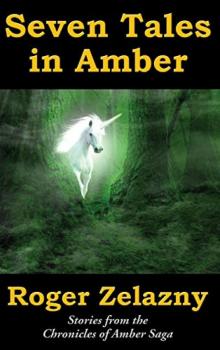 Seven Tales in Amber
Seven Tales in Amber Frost and Fire
Frost and Fire Doorways in the Sand
Doorways in the Sand Unicorn Variation
Unicorn Variation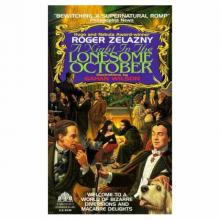 A Night in the Lonesome October
A Night in the Lonesome October Madwand
Madwand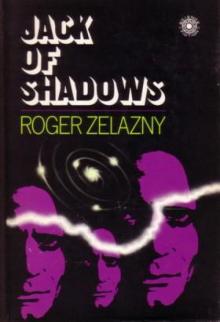 Jack Of Shadows
Jack Of Shadows Lord of Light
Lord of Light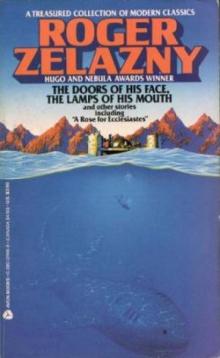 The Doors of His Face, The Lamps of His Mouth and Other Stories
The Doors of His Face, The Lamps of His Mouth and Other Stories Guns Of Avalon tcoa-2
Guns Of Avalon tcoa-2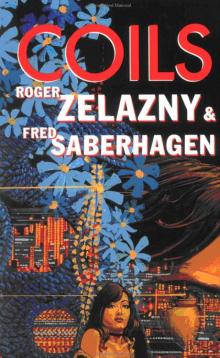 Coils
Coils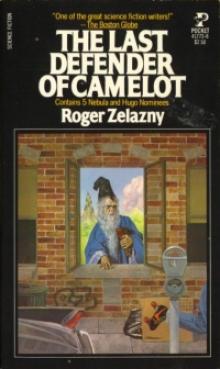 The Last Defender Of Camelot
The Last Defender Of Camelot Creatures of Light and Darkness
Creatures of Light and Darkness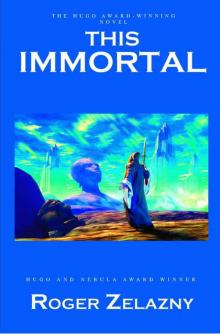 This Immortal
This Immortal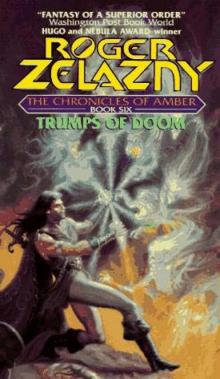 Trumps of doom tcoa-6
Trumps of doom tcoa-6 The Dream Master
The Dream Master The Complete Dilvish, The Damned
The Complete Dilvish, The Damned Nine Princes in Amber
Nine Princes in Amber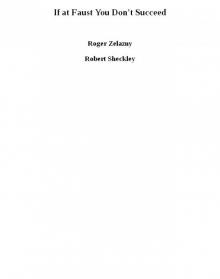 If at Faust You Don't Succeed
If at Faust You Don't Succeed Here there be dragons
Here there be dragons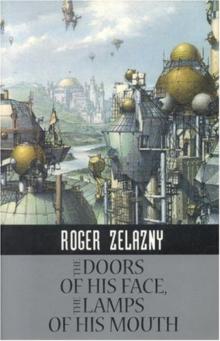 The Doors Of His Face, The Lamps Of His Mouth
The Doors Of His Face, The Lamps Of His Mouth The Great Book of Amber - Chronicles 1-10
The Great Book of Amber - Chronicles 1-10 Madwand (Illustrated)
Madwand (Illustrated) The Chronicles of Amber
The Chronicles of Amber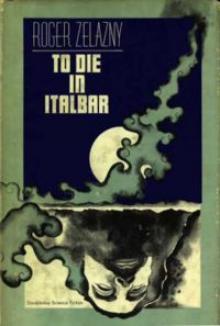 To Die In Italbar
To Die In Italbar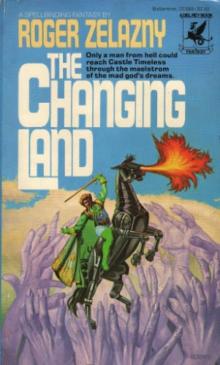 The Changing Land
The Changing Land The Furies
The Furies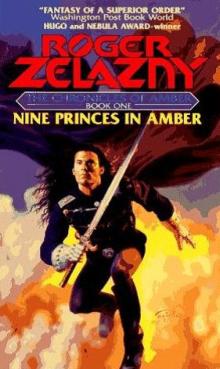 Nine Princes In Amber tcoa-1
Nine Princes In Amber tcoa-1 Last Of The Wild Ones
Last Of The Wild Ones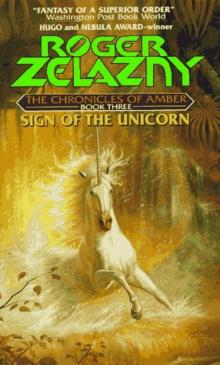 Sign of the Unicorn tcoa-3
Sign of the Unicorn tcoa-3 My Name is Legion
My Name is Legion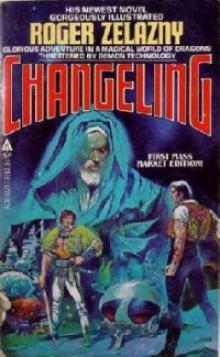 Wizard World 1: Changeling
Wizard World 1: Changeling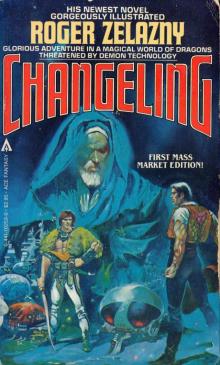 Changeling
Changeling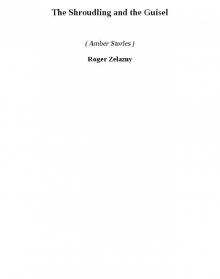 The Shroudling and the Guisel (amber stories)
The Shroudling and the Guisel (amber stories)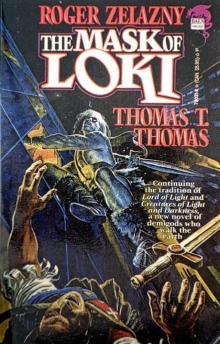 The Mask of Loki
The Mask of Loki A Farce To Be Reckoned With
A Farce To Be Reckoned With Roadmarks
Roadmarks When Pussywillows Last in the Catyard Bloomed (rtf)
When Pussywillows Last in the Catyard Bloomed (rtf)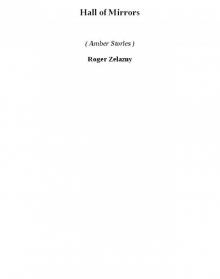 Hall of Mirrors (amber stories)
Hall of Mirrors (amber stories) Permafrost
Permafrost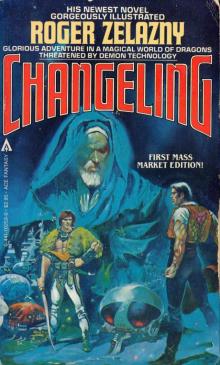 Changeling (Illustrated)
Changeling (Illustrated) Donnerjack
Donnerjack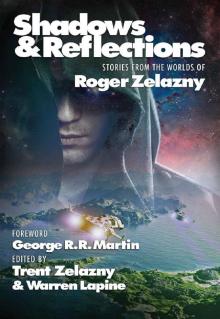 Shadows & Reflections: A Roger Zelazny Tribute Anthology
Shadows & Reflections: A Roger Zelazny Tribute Anthology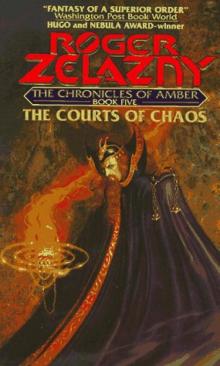 The Courts Of Chaos tcoa-5
The Courts Of Chaos tcoa-5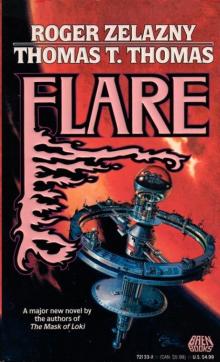 Flare
Flare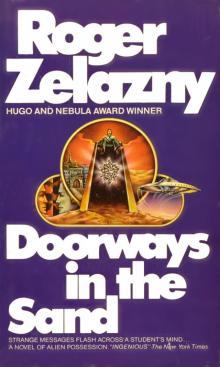 Doorsways in the Sand
Doorsways in the Sand The Great Book of Amber
The Great Book of Amber Home Is the Hangman
Home Is the Hangman For a Breath I Tarry
For a Breath I Tarry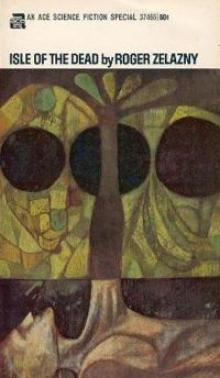 Isle Of The Dead
Isle Of The Dead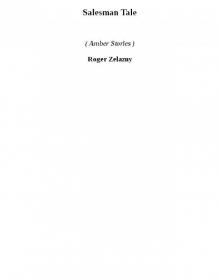 Salesman Tale (amber stories)
Salesman Tale (amber stories) Dismal Light
Dismal Light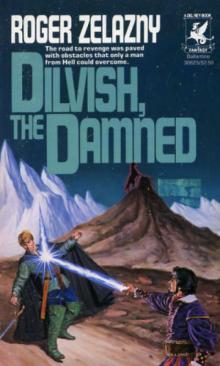 Dilvish, The Damned
Dilvish, The Damned The Black Throne
The Black Throne Wizard World 2: Madwand
Wizard World 2: Madwand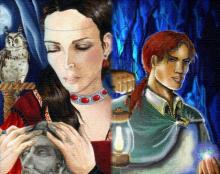 The Salesman's Tale
The Salesman's Tale